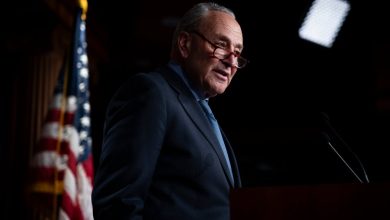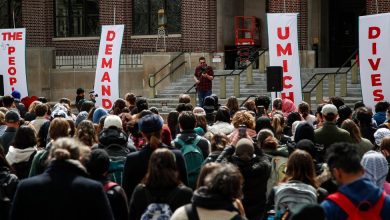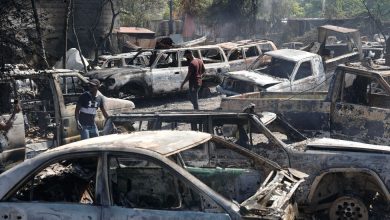F-1 in Las Vegas: A Roaring Spectacle for Fans, but a Huge Headache for Locals

Rajine Jones has a front-row seat to the Las Vegas Grand Prix, one of the most audacious events to roar into a city built on spectacle. Not that she will be able to see it.
On Saturday night, Formula One racecars will be hurtling down the Las Vegas Strip and buzzing past towering casinos, just outside the convenience store where Ms. Jones sells vape cartridges and energy drinks to tourists. But race organizers have shrouded the Strip in black tarp and fencing, and covered the glass on pedestrian walkways with white film and floodlights, obscuring the festivities from those without a $1,000 ticket.
“They blocked it,” Ms. Jones said, looking out her front doors at a line of tarp-covered fence. “We can’t see nothing.”
Race and county officials described the barriers and film as safety measures to protect the public and drivers. But to workers and small-business owners, it is the latest indignity of a monthslong construction project that has turned the Strip into a racetrack, while also causing huge headaches.
Race organizers and tourism officials have touted the Las Vegas Grand Prix as a sporting and economic success story years in the making — one that will infuse Las Vegas with celebrities, concerts and $1 billion in economic activity on a normally quiet pre-Thanksgiving weekend.
But local businesses and workers say they have been disproportionately forced to pay the price — in reduced profits, layoffs and exasperated hours stranded in traffic. They say that while the race may fill airports with private planes and penthouse suites with high-rollers, the losses suffered by everyday workers and small businesses are being overlooked.
“You can’t do this to a city,” said Wade Bohn, who runs Jay’s Market, a gas station and convenience store a few blocks off Las Vegas Boulevard, the formal name for the Strip.
He and other business owners say they have lost customers over the past six months as construction and road closures turned the Strip into a gridlocked labyrinth. Crews have repaved roads to accommodate Formula One racers going 200 miles per hour, built a pit area and erected temporary grandstands to accommodate 105,000 fans.
At Battista’s Hole in the Wall, an old-school Italian restaurant in the middle of the construction, revenue from each dinner shift has fallen by about $6,000 a night. The owner, Randy Markin, said he has stopped paying himself and can no longer afford to give his staff quarterly bonuses.
Hourly workers at casinos, hotels and restaurants also say they have been hit hard. Some waiters and bartenders have lost thousands of dollars in tips because of a drop in customers. Some people’s commute times have tripled.
“They don’t pay me for the extra time,” said Carmen Gomez, who works nights sweeping the pedestrian bridges that span Las Vegas Boulevard. She said her 15-minute bus ride to work now takes an hour.
Ms. Jones, 28, who works at the convenience store facing Las Vegas Boulevard, said she has to navigate one set of road closures and one-lane traffic to take her 8-year-old son and 2-year-old twins to a 24-hour day care, and then fight through a second gantlet to get from day care to her job. Her half-hour commute is now 90 minutes each way.
At the cherry-red Jay’s Market, Mr. Bohn struggled on Thursday to contain his emotions as he surveyed the half-empty store. He blamed a temporary bridge on Flamingo Road that had been built to carry traffic over one section of the racecourse. It has funneled customers away from him entirely.
Normally, his gas station is packed with tourists from California filling up their tanks and grabbing sandwiches, but he said his revenue this year is down $2.2 million compared with 2022.
He has laid off seven of his 12 employees, and said he does not know whether his store will survive if the Grand Prix becomes an annual event in the heart of the Strip, as local leaders envision. He said he has sent several emails and called the Clark County commissioners, who approved the race, but has not gotten any response. (Because the Strip and racecourse lie outside Las Vegas city limits, the event is overseen by the county).
Colleen Angel is one of the workers who was laid off from Mr. Bohn’s store. She had taken the job as a graveyard-shift cashier earlier this year in the hope that it would be steady work after years of doing various gigs such as teaching singing, performing in a classic-rock band and doing retail work.
She said the tensions swirling around the Grand Prix had highlighted the disparate treatment received by major corporations and the thousands of workers who keep the roulette wheels spinning, pillows plumped, floors gleaming and drinks cold.
“It’s not just about bad traffic for a few months,” she said. “It’s the people who work on the Strip. The reason people come here from all over the world, the amenities — it takes a lot of backbreaking work to keep it in place.”
Fans and race organizers are calling the Grand Prix a triumphant return that brings Formula 1 racing back to Las Vegas for the first time in 40 years. The race on Saturday is the first in what is expected to be a decade of racing, and local officials say they want a “lifetime partnership” with Formula 1 — part of a campaign to diversify the Strip with new sports stadiums and an otherworldly Magic 8 ball of an amphitheater called the Sphere.
County officials have said the race is expected to bring in $100 million in taxes and create at least 7,700 jobs.
“It has not all been sacrifice,” Jim Gibson, a county commissioner, told 8 News Now Las Vegas. Members of the county commission did not respond to interview requests, or declined to comment. Race organizers did not respond to a request for comment.
Earlier this fall, the commission sharply questioned race officials over their plans to help get thousands of casino employees to and from work. Some members of the commission have also balked at a request from the Grand Prix for Clark County to chip in $40 million to help pay for road work done for the race.
One of the questions still looming like a cloud of exhaust over the race is whether it can draw enough people to fill 105,000 seats and generate all of the predicted economic returns for Las Vegas. On Friday, the day before the race, there were still tickets available for the three-day event, and ticket prices on resale websites were going for less than full price.
Still, as the racecars revved up for their first practice run on Thursday night, the Strip was filled with thousands of excited fans from China, Mexico, Europe and across the United States, decked out in Ferrari T-shirts, Mercedes-Benz baseball caps and Red Bull racing jackets.
Some fans, like Jesus Nuñez, 31, who flew up from Mexico City with eight family members, could not afford tickets, so they perched along a railing outside a casino, hoping to catch a glimpse of the Mexican driver Sergio Pérez through the black-screened fencing. “It’s exciting,” he said.
Zia Hasan, who bought passes as a birthday present for his 17-year-old son, Shayan, said it was thrilling to wander down Las Vegas Boulevard beside the racing lights.
“The tickets are pricey, but it’s once in a lifetime,” he said.
A different kind of Las Vegas Grand Prix, however, is taking place away from the track and lights.
Out there on the clogged streets, Tsegaw Ashine, 38, a taxi driver who moved to Las Vegas in 2016, said he would love to watch the Grand Prix, but instead will spend race weekend weaving through the orange barrels, avoiding angry drivers and trying to earn enough to get by despite the gridlock.
“Our business is our time,” he said. “We’ve got to try to pick up more people.”




